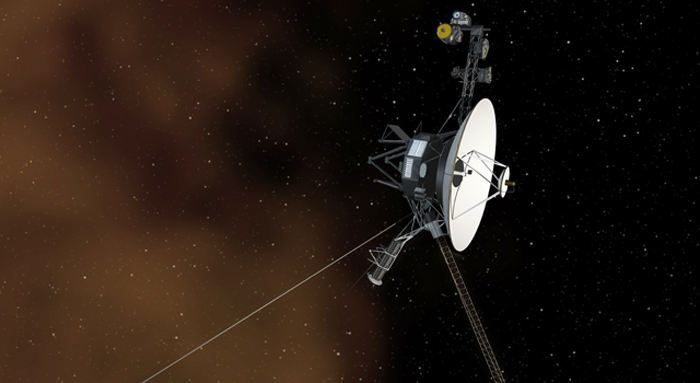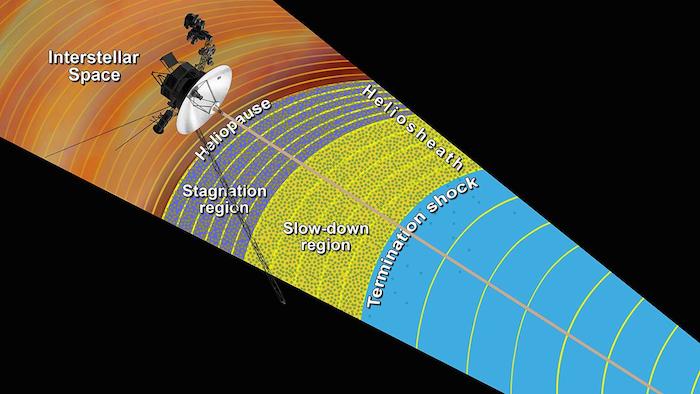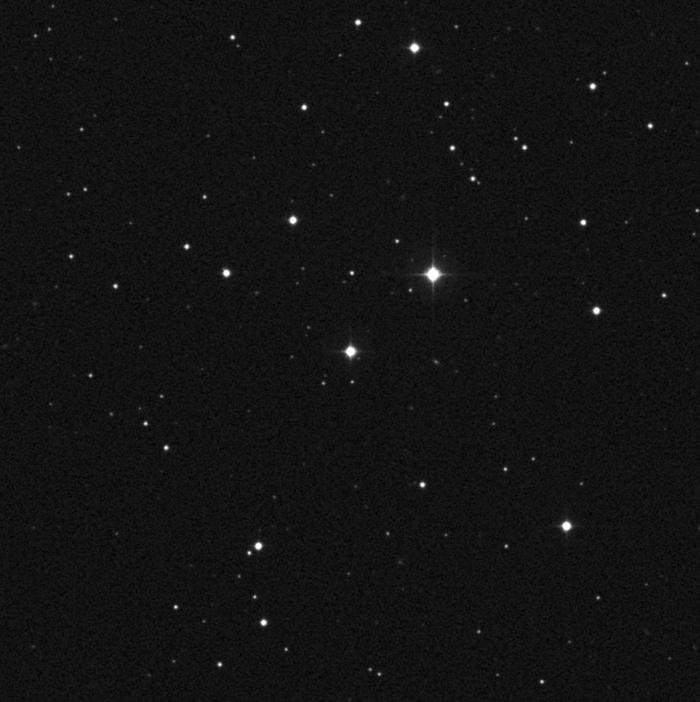.
8.07.2014

The Space Between: This artist's concept shows the Voyager 1 spacecraft entering the space between stars. Interstellar space is dominated by plasma, ionized gas (illustrated here as brownish haze), that was thrown off by giant stars millions of years ago. Image credit: NASA/JPL-Caltech
.
NASA's Voyager 1 spacecraft has experienced a new "tsunami wave" from the sun as it sails through interstellar space. Such waves are what led scientists to the conclusion, in the fall of 2013, that Voyager had indeed left our sun's bubble, entering a new frontier.
"Normally, interstellar space is like a quiet lake," said Ed Stone of the California Institute of Technology in Pasadena, California, the mission's project scientist since 1972. "But when our sun has a burst, it sends a shock wave outward that reaches Voyager about a year later. The wave causes the plasma surrounding the spacecraft to sing."
Data from this newest tsunami wave generated by our sun confirm that Voyager is in interstellar space -- a region between the stars filled with a thin soup of charged particles, also known as plasma. The mission has not left the solar system -- it has yet to reach a final halo of comets surrounding our sun -- but it broke through the wind-blown bubble, or heliosphere, encasing our sun. Voyager is the farthest human-made probe from Earth, and the first to enter the vast sea between stars.
"All is not quiet around Voyager," said Don Gurnett of the University of Iowa, Iowa City, the principal investigator of the plasma wave instrument on Voyager, which collected the definitive evidence that Voyager 1 had left the sun's heliosphere. "We're excited to analyze these new data. So far, we can say that it confirms we are in interstellar space."
Our sun goes through periods of increased activity, where it explosively ejects material from its surface, flinging it outward. These events, called coronal mass ejections, generate shock, or pressure, waves. Three such waves have reached Voyager 1 since it entered interstellar space in 2012. The first was too small to be noticed when it occurred and was only discovered later, but the second was clearly registered by the spacecraft's cosmic ray instrument in March of 2013.
Cosmic rays are energetic charged particles that come from nearby stars in the Milky Way galaxy. The sun's shock waves push these particles around like buoys in a tsunami. Data from the cosmic ray instrument tell researchers that a shock wave from the sun has hit.
Meanwhile, another instrument on Voyager registers the shock waves, too. The plasma wave instrument can detect oscillations of the plasma electrons.
"The tsunami wave rings the plasma like a bell," said Stone. "While the plasma wave instrument lets us measure the frequency of this ringing, the cosmic ray instrument reveals what struck the bell -- the shock wave from the sun."
This ringing of the plasma bell is what led to the key evidence showing Voyager had entered interstellar space. Because denser plasma oscillates faster, the team was able to figure out the density of the plasma. In 2013, thanks to the second tsunami wave, the team acquired evidence that Voyager had been flying for more than a year through plasma that was 40 times denser than measured before -- a telltale indicator of interstellar space.
Why is it denser out there? The sun's winds blow a bubble around it, pushing out against denser matter from other stars.
Now, the team has new readings from a third wave from the sun, first registered in March of this year. These data show that the density of the plasma is similar to what was measured previously, confirming the spacecraft is in interstellar space. Thanks to our sun's rumblings, Voyager has the opportunity to listen to the singing of interstellar space -- an otherwise silent place.
Voyager 1 and its twin, Voyager 2, were launched 16 days apart in 1977. Both spacecraft flew by Jupiter and Saturn. Voyager 2 also flew by Uranus and Neptune. Voyager 2, launched before Voyager 1, is the longest continuously operated spacecraft and is expected to enter interstellar space in a few years.
JPL, a division of Caltech, built and operates the twin Voyager spacecraft. The Voyagers Interstellar Mission is a part of NASA's Heliophysics System Observatory, sponsored by the Heliophysics Division of NASA's Science Mission Directorate in Washington. NASA's Deep Space Network, managed by JPL, is an international network of antennas that supports interplanetary spacecraft missions and radio and radar astronomy observations for the exploration of the solar system and the universe. The network also supports selected Earth-orbiting missions. The spacecraft's nuclear batteries were provided by the Department of Energy.
Quelle: NASA
.
Update: 19.12.2014
.
Voyager 1 Detects 'Tsunami' Wave From Sun Still Going Strong Beyond the Heliopause
.
Having long ago completed its epic journey of exploration and discovery through the outer Solar System, NASA’s Voyager 1 is the spacecraft that keeps on going more than 37 years after it was launched, while having already taken on its new role as humanity’s first robotic emissary to the stars. This historic passage into interstellar space, which occurred in August 2012, was marked by a steep increase in the levels of cosmic rays coming from interstellar space as measured by Voyager 1’s onboard instruments, accompanied by a sudden drop in the number of solar wind particles that originated from the Sun. Yet, despite having exited the Sun’s magnetic sphere of influence, the spacecraft can still feel the effects of its activity. Ongoing measurements taken throughout 2014 show that a “tsunami wave,” which was generated by the Sun in February, is still flying through interstellar space, providing scientists with new insights about the physics of the interstellar medium.
As described in a previous AmericaSpace article, the magnetosphere of the Sun, better known as the heliosphere, is a vast magnetic bubble that extends well beyond the planets of the Solar System. This realm is dominated by the outward flow of the solar wind—the steady stream of charged particles that is released by the Sun’s upper atmosphere at speeds that range between 400 and 800 km/second. Traversing interplanetary space along the magnetic field lines of our home star, the solar wind eventually slows down to subsonic speeds at a boundary called the termination shock, which is located between 84 and 94 Astronomical Units away from the Sun, until it is finally stopped altogether at the heliopause (the outer limits of the heliosphere) by the pressure of the stellar winds that stream through the interstellar medium.
.

An artist’s concept showing the outer layers of the Sun’s magnetosphere, or heliosphere, and the nearby interstellar space. Voyager 1 is currently exploring a region of interstellar space that still feels the influence from the charged particle of our home star’s magnetic field. The magnetic field lines (yellow arcs) appear to lie in the same general direction as the magnetic field lines emanating from our Sun. Image Credit: NASA/JPL-Caltech
.
The intensity of the Sun’s activity varies constantly, during a recurring 11-year period of heightened and decreased activity, also known as the “solar cycle.” Throughout this period, our home star can release a great number of solar flares and Coronal Mass Ejections, or CMEs, consisting of electromagnetic radiation and up to several billion tons of plasma in the form of highly energetic protons and electrons, which traverse the entire Solar System before reaching the very edges of the heliosphere several months after their initial explosion from the Sun. While crossing interplanetary space, CMEs plow through the solar wind forming shock waves which produce secondary streams of highly energetic particles that follow along the solar magnetic field lines. After reaching the boundaries of the heliosphere, these CMEs collide with and compress the plasma that is found in the interstellar medium, causing it to oscillate similar to the way the vibrating strings of a guitar create acoustic waves. “The tsunami causes the ionized gas that is out there to resonate – ‘sing’ or vibrate like a bell,” says Dr. Ed Stone, Voyager Project Scientist at NASA’s Jet Propulsion Laboratory, in Pasadena, Calif.
It was such magnetic “tsunamis” from the Sun that Voyager recorded with its onboard Plasma Wave System, or PWS, which helped scientists to ascertain when exactly the spacecraft had made its long-awaited jump to interstellar space in the first place. The first two were recorded in October to November 2012 and April to May 2013 respectively, while Voyager 1 was approximately 122 AU away from Earth, producing high-frequency oscillations which corresponded to a plasma density of over 40 times greater than what the spacecraft had ever measured before. Coupled with a sudden drop of the solar wind’s intensity and a steep rise of cosmic ray particles from interstellar space that were also recorded during that time, the Voyager’s science team was able to determine that the spacecraft had indeed made the big jump out of the heliosphere. The final confirmation came in February of this year, when a third tsunami wave washed over Voyager while it collided with dense interstellar plasma, beyond the boundaries of the heliopause. Yet what has been particularly interesting is that this third tsunami wave, which had been blasted from the Sun approximately a year before it first reached Voyager, seems to be going strong still, propagating outward through interstellar space as measured by the spacecraft’s instruments from February to November of this year, during which time Voyager itself has traveled an additional 400 million kilometers, while currently located at a distance of 130 AU from the Sun.
.

Voyager 1 is headed toward an encounter with the star AC +79 3888, also known as Gliese 445 (seen at the center of the image), which is located 17.6 light-years from Earth. In about 40,000 years, the spacecraft will be closer to this star than our own Sun. Image Credit: Caltech/Palomar
.
While these measurements are quite intriguing, it remains uncertain as to why these shock waves can last so long, or how far they can reach into space before dissipating altogether. “The density of the plasma is higher the farther Voyager goes,” says Stone. “Is that because the interstellar medium is denser as Voyager moves away from the heliosphere, or is it from the shock wave itself? We don’t know yet.” Nevertheless, since Voyager 1 is truly into uncharted territory, every single measurement is bound to be a revelation, allowing scientists to directly probe the physical processes that take place in interstellar space for the first time in human history. “This remarkable event raises questions that will stimulate new studies of the nature of shocks in the interstellar medium,” says Leonard Burlaga, astrophysicist emeritus at NASA’s Goddard Spaceflight Center in Greenbelt, Md., who was involved in the analysis of the new Voyager 1 data.
Even though Voyager 1 has already provided us with many revolutionary insights concerning the interstellar medium, its onboard Plasma Spectrometer, which could have taken direct measurements of the plasma environment of interstellar space, had stopped working following the spacecraft’s encounter with Saturn back in 1980. Fortunately, a similar instrument onboard the twin Voyager 2 spacecraft, which is also on an outward trajectory from the Solar System, is still functioning. Voyager 2, which is still located inside the heliosphere at a current distance of 107 AU from Earth, is expected to follow suit and cross the heliopause sometime within the next 4 to 5 years. When that happens, the spacecraft will be able to provide us with much more detailed observations of the environment of interstellar space. “Most people would have thought the interstellar medium would have been smooth and quiet,” said Dr. Donald Gurnett, a physics professor at the University of Iowa and principal investigator of Voyager’s Plasma Wave instrument, during a press conference at the recent American Geophysical Union meeting in San Francisco, earlier this month. “But these shock waves seem to be more common than we thought.”
We cannot be sure for how long exactly the instruments onboard Voyager 1 and 2 will be able to transmit data back to Earth. Nevertheless, both spacecraft are expected to have enough electrical power to do so until at least the mid-2020s, should their instrumentation remain in good condition. What is certain, however, is that as long as these iconic robotic pioneers remain operational, they will keep making history with new results, as they quietly sail the open seas of interstellar space.
Quelle: AS
4661 Views
